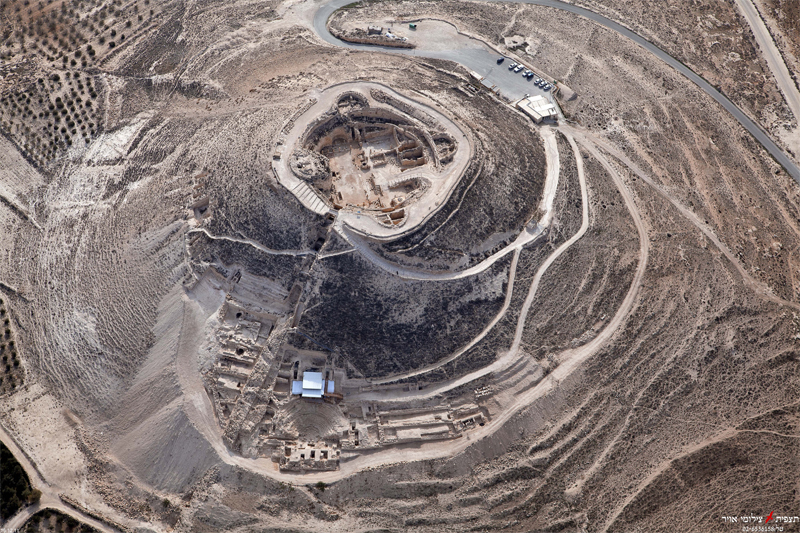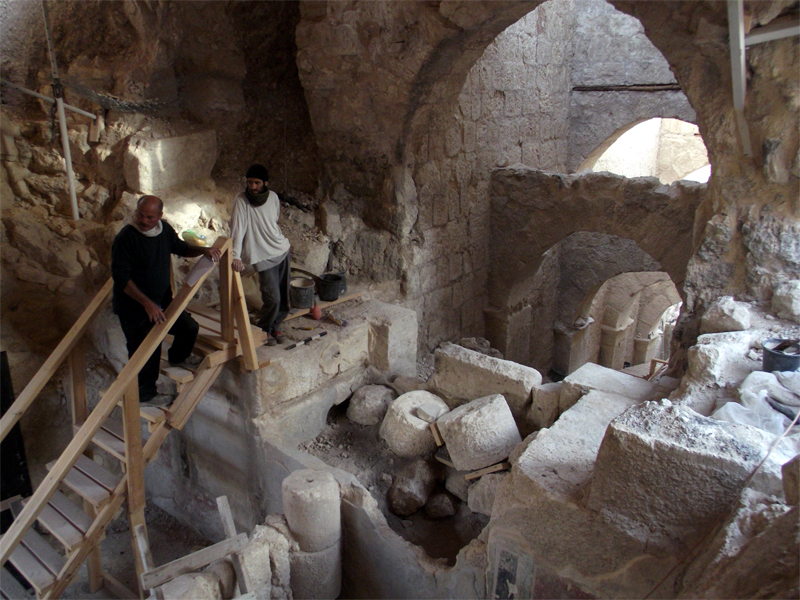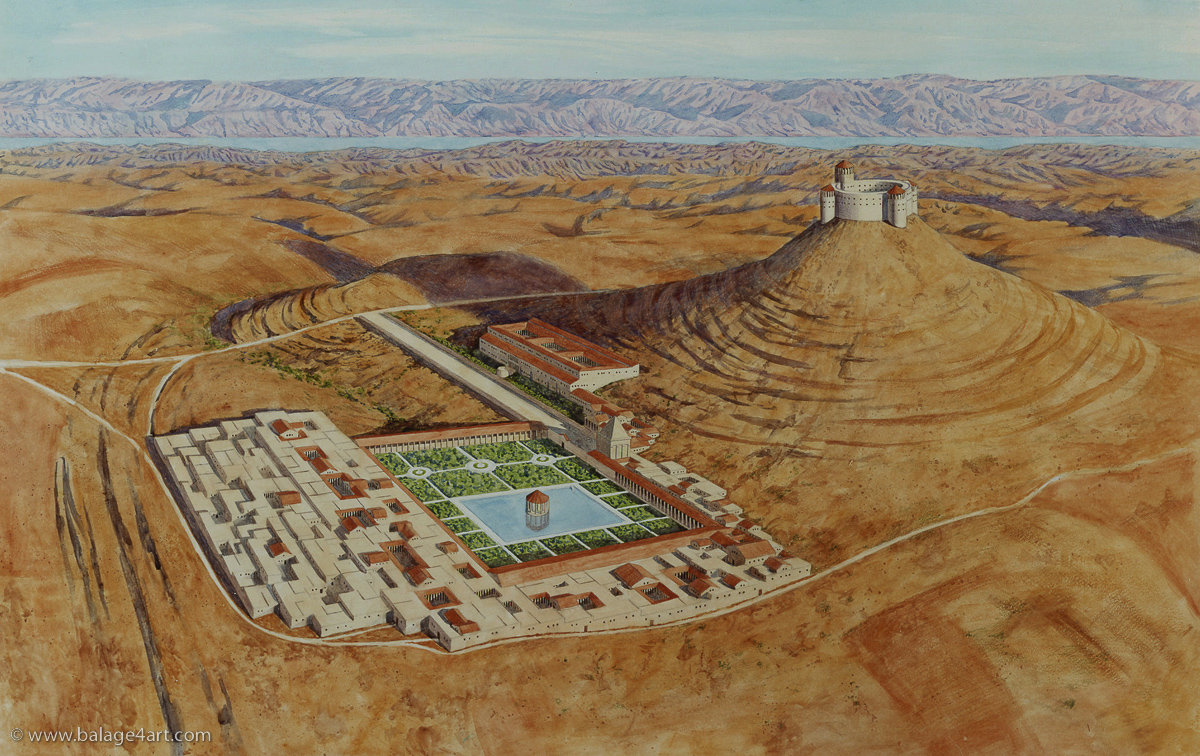It looks like you're using an Ad Blocker.
Please white-list or disable AboveTopSecret.com in your ad-blocking tool.
Thank you.
Some features of ATS will be disabled while you continue to use an ad-blocker.
26
share:
This popped up on my feed a few minutes ago and I thought it was worth a share for the pictures alone!
First a little background:
About seven and half miles south of Jerusalem sits a man-made mountain in the Judean desert on which is perched a fortified palace compound of King Herod. Herodium (aka Herodion) is comprised of the hilltop fortress/palace, a lower palace and a town. At 2,487 ft (758 meters), the upper palace sits upon the highest peak in the Judean desert. The site is believed to be the place where King Herod was buried. What is thought to be the tomb of Herod was uncovered at the site in 2007 though its identification as such has been challenged by some notable archaeologists.
Much of the site remains to be excavated but among the sections that have been are a Roman bathhouse and theater, a synagogue and the aforementioned mausoleum. The floors are decorated with large mosaics and the walls with frescoes thought to have been created by artists on loan from Julius Caesar. Construction of the site started sometime after 40 BC, following a great victory over the Parthians.
 Aerial view of Herodium. Credit: Tatzpit Aerial Photography via
Past
Horizons
Aerial view of Herodium. Credit: Tatzpit Aerial Photography via
Past
Horizons
The description of Herodium from the Romano-Jewish historian Josephus:
This fortress, which is some sixty stadia distant from Jerusalem, is naturally strong and very suitable for such a structure, for reasonably nearby is a hill, raised to a (greater) height by the hand of man and rounded off in the shape of a breast. At intervals it has round towers, and it has a steep ascent formed of two hundred steps of hewn stone. Within it are costly royal apartments made for security and for ornament at the same time. At the base of the hill there are pleasure grounds built in such a way as to be worth seeing, among other things because of the way in which water, which is lacking in that place, is brought in from a distance and at great expense. The surrounding plain was built up as a city second to none, with the hill serving as an acropolis for the other dwellings.
Starting in 1972, excavations at the site were conducted by a team from the The Hebrew University of Jerusalem under the leadership of famed Israeli archaeologist, Ehud Netzer. After Netzer's death in 2010, excavations stopped for a time but they've now resumed and the latest discovery is that of a monumental entrance.
From Past Horizons:
 Section of the newly uncovered entrance. Credit: Herodium Expedition via
Past
Horizons
Section of the newly uncovered entrance. Credit: Herodium Expedition via
Past
Horizons
Finally, a rendering of Herodium from artist Balage Balogh (larger image):

First a little background:
About seven and half miles south of Jerusalem sits a man-made mountain in the Judean desert on which is perched a fortified palace compound of King Herod. Herodium (aka Herodion) is comprised of the hilltop fortress/palace, a lower palace and a town. At 2,487 ft (758 meters), the upper palace sits upon the highest peak in the Judean desert. The site is believed to be the place where King Herod was buried. What is thought to be the tomb of Herod was uncovered at the site in 2007 though its identification as such has been challenged by some notable archaeologists.
Much of the site remains to be excavated but among the sections that have been are a Roman bathhouse and theater, a synagogue and the aforementioned mausoleum. The floors are decorated with large mosaics and the walls with frescoes thought to have been created by artists on loan from Julius Caesar. Construction of the site started sometime after 40 BC, following a great victory over the Parthians.

The description of Herodium from the Romano-Jewish historian Josephus:
This fortress, which is some sixty stadia distant from Jerusalem, is naturally strong and very suitable for such a structure, for reasonably nearby is a hill, raised to a (greater) height by the hand of man and rounded off in the shape of a breast. At intervals it has round towers, and it has a steep ascent formed of two hundred steps of hewn stone. Within it are costly royal apartments made for security and for ornament at the same time. At the base of the hill there are pleasure grounds built in such a way as to be worth seeing, among other things because of the way in which water, which is lacking in that place, is brought in from a distance and at great expense. The surrounding plain was built up as a city second to none, with the hill serving as an acropolis for the other dwellings.
Starting in 1972, excavations at the site were conducted by a team from the The Hebrew University of Jerusalem under the leadership of famed Israeli archaeologist, Ehud Netzer. After Netzer's death in 2010, excavations stopped for a time but they've now resumed and the latest discovery is that of a monumental entrance.
From Past Horizons:
The main feature of the entryway is an impressive corridor with a complex system of arches spanning its width on three separate levels. These arches buttressed the corridor’s massive side-walls, allowing the King and his entourage direct passage into the Palace Courtyard. Thanks to the supporting arches, the 20-metre long and 6-metre wide corridor has been preserved to a height of 20 metres.
Surprisingly, during the course of the excavations, it became evident that the arched corridor was never actually in use, as prior to its completion it became redundant. This appears to have happened when Herod, aware of his impending death, decided to convert the whole hilltop complex into a massive memorial mound, a royal burial monument on an epic scale.
Whatever the case, the corridor was back-filled during the construction of the massive artificial hill at the end of Herod’s reign. The upper section of a new monumental stairway stretching from the hill’s base to its peak, constructed during the course of this building phase, appears to have been built over it.

Finally, a rendering of Herodium from artist Balage Balogh (larger image):

edit on 2014-12-18 by theantediluvian because: (no reason given)
Very impressive!
Thanks for keeping us abreast of the latest ancient wonders!
Thanks for keeping us abreast of the latest ancient wonders!
edit on 18-12-2014 by antoinemarionette because: added word
Thanks for the link to your feed. Makes you really appreciate what we have these days.
The past is so awesome, there's so much we don't understand, maybe someday the truth will be known.
a reply to: theantediluvian
It Seems asthough Herod is credited with building literally EVERYTHING in Israel.
I know he was a great King and prolific commissioner of building sites, but did any other ancient Judean, save Solomon the Wise, build?
Christosterone
It Seems asthough Herod is credited with building literally EVERYTHING in Israel.
I know he was a great King and prolific commissioner of building sites, but did any other ancient Judean, save Solomon the Wise, build?
Christosterone
a reply to: Christosterone
Herod had a habit of building really big things with other people's money.
Herod had a habit of building really big things with other people's money.
new topics
-
Orbs Appear And Form Triangle On Live Cam.
Aliens and UFOs: 1 hours ago -
Biden Has New Bizarre Injuries to His Face
Politicians & People: 2 hours ago -
Something is not adding up in regards to the H-1B commotion
General Conspiracies: 3 hours ago -
Elon Musk Calls for Tommy Robinson to be Freed - and Takes a Dig at Starmer
Politicians & People: 4 hours ago -
Biden to award Presidential Citizens Medal to Liz Cheney and Bennie Thompson
US Political Madness: 4 hours ago -
Just learned a really helpful trick for internet searches
Computer Help: 10 hours ago -
Not off to a good start
General Chit Chat: 11 hours ago
top topics
-
Biden Has New Bizarre Injuries to His Face
Politicians & People: 2 hours ago, 9 flags -
Just learned a really helpful trick for internet searches
Computer Help: 10 hours ago, 7 flags -
Biden to award Presidential Citizens Medal to Liz Cheney and Bennie Thompson
US Political Madness: 4 hours ago, 7 flags -
Not off to a good start
General Chit Chat: 11 hours ago, 6 flags -
Elon Musk Calls for Tommy Robinson to be Freed - and Takes a Dig at Starmer
Politicians & People: 4 hours ago, 5 flags -
Something is not adding up in regards to the H-1B commotion
General Conspiracies: 3 hours ago, 5 flags -
Orbs Appear And Form Triangle On Live Cam.
Aliens and UFOs: 1 hours ago, 2 flags
active topics
-
Tesla Cybertruck Explodes in Front of Trump Hotel in Las Vegas
Mainstream News • 104 • : Ravenwatcher -
Vehicle Strikes people in New Orleans
Mainstream News • 270 • : BeyondKnowledge3 -
-@TH3WH17ERABB17- -Q- ---TIME TO SHOW THE WORLD--- -Part- --44--
Dissecting Disinformation • 3894 • : NightFlight -
Strange fog all over the northern hemisphere
General Conspiracies • 43 • : annonentity -
The Acronym Game .. Pt.4
General Chit Chat • 1033 • : tinkerbell99 -
Ukraine halts transit of Russian gas to Europe after a prewar deal expired
Political Conspiracies • 111 • : Oldcarpy2 -
Post A Funny (T&C Friendly) Pic Part IV: The LOL awakens!
General Chit Chat • 7979 • : chiefsmom -
Biden Has New Bizarre Injuries to His Face
Politicians & People • 9 • : CarlLaFong -
If they can see...they can read!!
Rant • 28 • : AlroyFarms -
Biden to award Presidential Citizens Medal to Liz Cheney and Bennie Thompson
US Political Madness • 12 • : DAVID64
26
